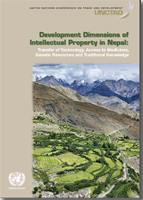
Part 1 of this Report outlines the major framework for intellectual property (IP) policy in Nepal. IP rights have differential impact on countries based on their respective levels of development, with LDCs being in a less advantageous position due to their limited absorptive capacity and technological base, among other limitations.
Considering its level of development, IP policy makers in Nepal needs to consider the importance of and the factors that facilitate indigenous learning activities and the adaptation of technologies, through incremental innovation in vital and promising sectors of the economy.
Part 2 of the Report recommends a number of legislative, policy and practical steps to facilitate and enable the technological and innovation functions of IP protection.
Part 3 of the Report examines the access to medicine regime of Nepal and recommends for Nepal to implement the transition period for the protection of pharmaceutical product patents and pharmaceutical test data that lasts until 2033.
Part 4 of the Report analyses Nepal's access and benefit sharing regime, the interface between IP and biodiversity, and options for defensive and positive protection of genetic resources (GRs) and traditional knowledge (TK).
The recommendations of this Report on the framework for IP policy in Nepal and on each specific area examined have legislative and institutional dimensions that require capacity building, and, in some cases, additional studies to develop specific action plans for implementation. This Report serves as a good basis for identifying Nepal's priority needs for technical and financial cooperation.



